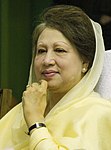February_1996_Bangladeshi_general_election
General elections were held in Bangladesh on 15 February 1996. They were boycotted by most opposition parties, and saw voter turnout drop to just 21%.[1] The result was a victory for the Bangladesh Nationalist Party (BNP), which won 278 of the 300 directly elected seats.[1] This administration was short-lived, however, only lasting 12 days[2] before the installation of caretaker government and fresh elections held in June.
